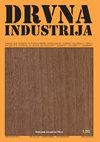Usporedba reakcijskoga i normalnog drva nekih komercijalnih vrsta drva
IF 0.8
4区 农林科学
Q4 MATERIALS SCIENCE, PAPER & WOOD
引用次数: 0
Abstract
This study aims to analyze the reaction wood samples for some industrial tree species naturally grown in Kastamonu province in Turkey and compare them with the relevant standards. Some anatomical, chemical, fiber morphological, optical properties, and color changes before and after drying were analyzed for the reaction wood (RW) samples. While the holocellulose content of fir and pine compression wood (CW) was found to be lesser (~3-4 %), the lignin content was higher than those of the opposite wood (OW) (~34 % for pine and 12 % for fir). On the contrary, the amount of holocellulose was found to be higher (~1-4 %), and the lignin was lower (at about 6-15 %) in the tension wood (TW) samples. It was observed that average lengths are more extended in TW(~50-54 %) and shorter in CW (~13-17 %) than those of OW. Significant differences were observed between the anatomical structures of the coniferous and deciduous species studied. Although, the greatest color differences in wet and oven-dried samples of coniferous trees were measured in CW (~15-17 %), it has been found as about 0.7-3 % in TW for deciduous species. Some differences were observed in the anatomical, optical, fiber morphological, and chemical properties of the RW for the studied wood species. Due to its higher lignin content and better physical properties, CW can be used for producing small households and hand tools, ornaments, toys, etc. It will also be appropriate for use in milling and turning work. It is recommended that, because of the lower lignin content and higher polysaccharide ratio, TW should be primarily used for the cellulose, pulp, and paper industries, where high mechanical resistance values are required. Consequently, RW formation causes some physical, chemical, mechanical, anatomical, and optical differences compared to OW in deciduous and coniferous species.某些商用木材类型的反应木和正常木的排列方式
本研究旨在分析土耳其卡斯塔莫努省自然生长的一些工业树种的反应木样本,并将其与相关标准进行比较。研究分析了反应木(RW)样品的一些解剖、化学、纤维形态、光学特性以及干燥前后的颜色变化。结果发现,杉木和松木压缩木(CW)的全纤维素含量较低(约为 3-4%),但木质素含量却高于对生木(OW)(松木约为 34%,杉木为 12%)。相反,在张力木 (TW) 样品中,全纤维素含量较高(约 1-4%),木质素含量较低(约 6-15%)。据观察,与 OW 样品相比,TW 样品的平均长度更长(约 50-54%),而 CW 样品的平均长度较短(约 13-17%)。所研究的针叶树种和落叶树种的解剖结构之间存在显著差异。虽然针叶树湿样和烘干样的色差在 CW 中最大(约 15-17%),但落叶树种的色差在 TW 中约为 0.7-3%。所研究的木材种类在 RW 的解剖学、光学、纤维形态和化学特性方面都存在一些差异。由于木质素含量较高,物理性质较好,CW 可用于生产小型家用和手动工具、装饰品、玩具等。它也适合用于铣削和车削工作。由于木质素含量较低,多糖比例较高,建议将 TW 主要用于纤维素、纸浆和造纸工业,因为这些行业需要较高的机械阻力值。因此,与落叶树种和针叶树种的 OW 相比,RW 的形成会导致一些物理、化学、机械、解剖学和光学方面的差异。
本文章由计算机程序翻译,如有差异,请以英文原文为准。
求助全文
约1分钟内获得全文
求助全文
来源期刊

Drvna Industrija
MATERIALS SCIENCE, PAPER & WOOD-
CiteScore
1.80
自引率
9.10%
发文量
32
审稿时长
>12 weeks
期刊介绍:
"Drvna industrija" ("Wood Industry") journal publishes original scientific and review papers, short notes, professional papers, conference papers, reports, professional information, bibliographical and survey articles and general notes relating to the forestry exploitation, biology, chemistry, physics and technology of wood, pulp and paper and wood components, including production, management and marketing aspects in the woodworking industry.
 求助内容:
求助内容: 应助结果提醒方式:
应助结果提醒方式:


